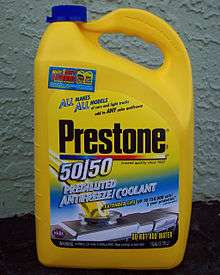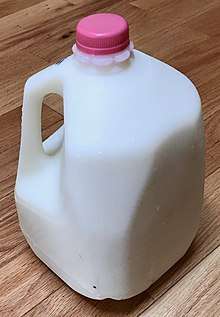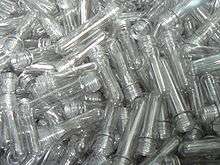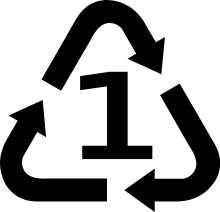Plastic bottle


A plastic bottle is a bottle constructed from plastic. Plastic bottles are typically used to store liquids such as water, soft drinks, motor oil, cooking oil, medicine, shampoo, milk, and ink. The size ranges from very small sample bottles to large carboys. Some consumer blow molded containers have integral handles.[2]
History
Plastic bottles were first used commercially in 1947 but remained relatively expensive until the early 1950s when high-density polyethylene was introduced.[3] They quickly became popular with both manufacturers and customers due to their lightweight nature and relatively low production and transportation costs compared with glass bottles.[4][5][6] However, the biggest advantage plastic bottles have over glass is their superior resistance to breakage, in both production and transportation. Except for wine and beer, the food industry has almost completely replaced glass bottles with plastic bottles.
Production


The materials used in the manufacture of plastic bottles vary by application.[7][8]
Petrochemical resins
- High-density polyethylene (HDPE)
- HDPE is the most widely used resin for plastic bottles. This material is economical, impact resistant, and provides a good moisture barrier. HDPE is compatible with a wide range of products including acids and caustics but is not compatible with solvents. It is supplied in FDA-approved food grade. HDPE is naturally translucent and flexible. The addition of color will make HDPE opaque, but not glossy. HDPE lends itself to silk screen decoration. While HDPE provides good protection at below freezing temperatures, it cannot be used with products filled above 190 °F (88 °C) or products requiring a hermetic (vacuum) seal.
- Fluorine-treated HDPE
- These bottles are exposed to fluorine gas in a secondary operation, are similar in appearance to HDPE, and serve as a barrier to hydrocarbons and aromatic solvents. Fluorine-treated bottles may contain insecticides, pesticides, herbicides, photographic chemicals, agricultural chemicals, household and industrial cleaners, electronic chemicals, medical cleaners and solvents, citrus products, d-limonene, flavors, fragrances, essential oils, surfactants, polishes, additives, graffiti cleaning products, pre-emergents, stone and tile care products, waxes, paint thinner, gasoline, biodiesel, xylene, acetone, kerosene and more.
- Low-density polyethylene (LDPE)
- LDPE is similar in composition to HDPE. It is less rigid and generally less chemically resistant than HDPE, but is more translucent. LDPE is used primarily for squeeze applications. LDPE is significantly more expensive than HDPE.
- Polyethylene terephthalate (PET, PETE) / Polyester
- This resin is commonly used for carbonated beverages, water bottles, and food packaging. PET provides very good alcohol and essential oil barrier properties, generally good chemical resistance (although acetones and ketones will attack PET) and a high degree of impact resistance and tensile strength. The orienting process serves to improve gas and moisture barrier properties and impact strength. This material is not resistant at high temperature. Its maximum temperature is 200 °F (93 °C).
- Polycarbonate (PC)
- PC is a clear plastic used to make bottles for milk and water. Five-gallon water bottles are a common application of PC.
- Polypropylene (PP)
- PP is used primarily for jars and closures. It is rigid and is a barrier to moisture. Polypropylene is stable at temperatures up to 220 °F (104 °C). it is autoclavable and offers the potential for steam sterilization. The compatibility of PP with high filling temperatures is responsible for its use with hot fill products. PP has excellent chemical resistance, but provides poor impact resistance in cold temperatures.
- Polystyrene (PS)
- PS is transparent and rigid. It is commonly used with dry products, including vitamins, petroleum jellies, and spices. Styrene does not provide good barrier properties, and exhibits poor impact resistance.
- Polyvinyl chloride (PVC)
- PVC is naturally clear. It has high resistance to oils, and has transmits very little oxygen. It provides a strong barrier to most gases, and its drop-impact resistance is also very good. This material is chemically resistant, but it is vulnerable to some solvents. PVC has poor resistance to high temperatures and will distort at 160 °F (71 °C), making it incompatible with hot-filled products. It has attained notoriety in recent years due to potential health risks.
- Post-consumer resin (PCR)
- PCR is a blend of reclaimed natural HDPE (primarily from milk and water containers) and virgin resin. The recycled material is cleaned, ground and recompounded into uniform pellets along with prime virgin material especially designed to build up environmental stress crack resistance. PCR has no odor but exhibits a slight yellow tint in its natural state. This tint can be hidden by the addition of color. PCR is easily processed and inexpensive. However, it cannot come into direct contact with food or pharmaceutical products. PCR can be produced in a variety of recycled content percentages up to 100%.
- K-Resin (SBC)
- SBC is a highly transparent, high-gloss, impact-resistance resin. K-Resin, a styrene derivative, is processed on polyethylene equipment. It is specifically incompatible with fats and unsaturated oils or solvents. This material is frequently used for display and point-of-purchase packaging.
Other materials
- Bioplastic
- A bioplastic is a polymer structure based on processed biological materials rather than petrochemicals. Bioplastics are commonly made from renewable sources like starch, vegetable oil, and less commonly, chicken feathers. The idea behind bioplastic is to create a plastic that has the ability to biodegrade.[9]
- Bisphenol A (BPA):
- BPA is a synthetic compound that serves as a raw material in the manufacturing of such plastics as polycarbonates and epoxy resins. It is commonly found in reusable drink containers, food storage containers, canned foods, and children's toys. BPA can seep into food or beverages from containers that are made with BPA.[10]
Health and environmental issues
There is ongoing concern as to the use of plastics in consumer food packaging solutions, environmental impact of the disposal of these products, as well as concerns regarding consumer safety. Karin Michaels, Associate Professor at Harvard Medical School, suggests that toxins leaching from plastics might be related to disorders such as infertility and cancer in humans.[11]
In the United States, plastic water bottles are regulated by the FDA which also inspects and samples bottled water plants periodically. Plastic water bottle plants hold a low priority for inspection due to a continuously good safety record.[12] In the past, the FDA maintained that there was a lack of human data showing plastics pose health problems, however in January 2010, the FDA reversed its opinion saying they now have concerns about health risks.[11] An article published on November 6, 2017 in Water Research reported on the content of microplastics in mineral waters packed in plastic or glass bottles, or beverage cartons.[13] In 2018, research conducted by Sherri Mason from the State University of New York in Fredonia revealed the presence of polypropylene, polystyrene, nylon and polyethylene terephthalate microparticles in plastic bottles. Polypropylene was hereby found to be the most common polymeric material (54%) and nylon the second most abundant (16%) polymeric material. The study also mentioned that polypropylene and polyethylene are polymers that are often used to make plastic bottle caps. Also, 4% of retrieved plastic particles were found to have signatures of industrial lubricants coating the polymer.[14] The research was reviewed by Andrew Mayes of the University of East Anglia (UEA) School of Chemistry[15]The European Food Safety Authority suggested most microplastics are excreted by the body, however the UN Food and Agriculture Organization warned that it is possible that the smallest particles (< 1.5 μm) could enter the bloodstream and organs, via the intestinal wall.[16][17][18]
Labelling

Plastic bottles are marked at their base with the resin identification code to indicate the material used.[19]
See also
References
- ↑ Sandra Laville and Matthew Taylor, "A million bottles a minute: world's plastic binge 'a climate change'", TheGuardian.com, 28 June 2017 (page visited on 20 July 2017).
- ↑ Birkby, David (May 2014). "PET bottle handle—N.A. success story". Canadian Packaging. Retrieved 29 May 2018.
- ↑ "The History of soft drink Timeline". Retrieved 2008-04-23.
- ↑ "Plastic vs. Glass - Why Plastic Containers Are Better". Packaging of the World. Retrieved 22 October 2015.
- ↑ "The Advantages of Plastic Bottles". Seattle Pi. Retrieved 22 October 2015.
- ↑ "Benefits of Plastic Packaging". Plastic Packaging. Retrieved 22 October 2015.
- ↑ "plastic bottle resin materials". www.ebottles.com. Retrieved 2017-10-15.
- ↑ "Plastic packaging manufacturers". 3Plastics. Retrieved 1 January 2018.
- ↑ http://plasticisrubbish.com/2013/03/07/what-is-bioplastic-2/
- ↑ "Tips to reduce your exposure to BPA". Mayo Clinic. 2016-03-11. Retrieved 2018-02-26.
- 1 2 "Plastic packaging is injurious to health". thehindubusiness.com. Retrieved 3 May 2015.
- ↑ http://www.fda.gov/Food/FoodborneillnessContaminants/BuyStoreServeSafeFood/ucm077079.htm
- ↑ Schymanski, Darena; Goldbeck, Christophe; Humpf, Hans-Ulrich; Fürst, Peter (2018). "Analysis of microplastics in water by micro-Raman spectroscopy: Release of plastic particles from different packaging into mineral water". Water Research. Elsevier BV. 129: 154–162. doi:10.1016/j.watres.2017.11.011. ISSN 0043-1354.
- ↑ SYNTHETIC POLYMER CONTAMINATION IN BOTTLED WATER
- ↑ Plus Plastic MICROPLASTICS FOUND IN GLOBAL BOTTLED WATER
- ↑ WATER STUDY Are there plastic particles in bottled water, which brands are affected and is it still safe to drink?
- ↑ [onlinelibrary.wiley.com/doi/10.2903/j.efsa.2016.4501/full Presence of microplastics and nanoplastics in food, with particular focus on seafood]
- ↑ Plastic and Human Health: A Micro Issue?
- ↑ Dr, STEVE ESOMBA. TWENTY-FIRST CENTURY'S FUEL SUFFICIENCY ROADMAP. Lulu.com. ISBN 9781471734311.
Books
- Soroka, W. (2002). Fundamentals of Packaging Technology. IoPP. ISBN 1-930268-25-4
- Yam, K. L. (2009). Encyclopedia of Packaging Technology. 978-0-470-0870
External links
| Wikimedia Commons has media related to Plastic bottles. |